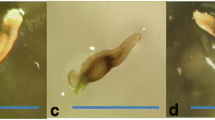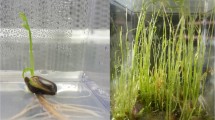Abstract
Xyris tennesseensis is a critically endangered species native to the southeastern USA. A micropropagation protocol was developed which may assist in the safeguarding and augmentation of dwindling natural populations of this ecologically and medically valuable plant. Four different batches of seeds were sterilized using hydrogen peroxide and germinated in vitro on modified one third-strength Murashige and Skoog medium. Shoot multiplication from seedling tissue was obtained using modified one third-strength Murashige and Skoog medium containing 1 mg/l kinetin and 0.1–0.5 mg/l α-naphthaleneacetic acid. Optimal shoot size and sustainable multiplication rates of three to five per 2-mo subculture occurred on medium containing 0.3–0.4 mg/l α-naphthaleneacetic acid. Shoots rooted successfully when placed on growth regulator-free medium for 10 d followed by transfer to greenhouse soil under high humidity. Use of seed cryopreservation resulted in significant increases in germination compared to control treatments with average germination rates of 97%. Shoot tip cultures from soil-grown plants of X. tennesseensis and Xyris spathifolia were also developed using the above protocols. Plant tissue culture tools will assist in the multiplication, long-term storage, and conservation of these rare and valuable plants as well as provide a template for the micropropagation of other Xyris species.




Similar content being viewed by others
References
Baskin C.; Baskin J. Seed germination and propagation of Xyris tennesseensis, a federal endangered wetland species. Wetlands 23: 116–124; 2003.
Boyd R. S.; Moffett J. M. Jr. Management of Xyris tennesseensis (Tennessee yellow-eyed grass), a federally-endangered plant species. Final Report GDOT Research Project No. 2003. www.dot.state.ga.us; 2003.
Boyd R. S.; Moffett J. M. Jr. Population survey of the federally endangered Tennessee yellow-eyed grass (Xyris tennesseensis). Unpublished report prepared for the United States Fish and Wildlife Service. Daphne Field Office, Daphne, AL, USA; 2010: 13 pp.
Endringer D. C.; Valadares Y. M.; Campana P. R. V.; Campos J. J.; Guimaraes K. G.; Pezzuto J. M.; Braga F. C. Evaluation of Brazilian plants on cancer chemoprevention targets in vitro. Phytotherapy Res 24: 928–933; 2010.
Englemann F. Use of biotechnologies for the conservation of plant biodiversity. In Vitro Cell Dev Biol-Plant 47: 5–16; 2011.
Fay M. F. Conservation of rare and endangered plants using in vitro methods. In vitro Cell Dev Biol-Plant 28: 1–4; 1992.
International Union for Conservation of Nature. IUCN Red List of Threatened Species. Version 2010.1 www.iucnredlist.org. Cited 22 June 2010.
Kaeppler S. M.; Kaeppler H. F.; Rhee Y. Epigenetic aspects of somaclonal variation in plants. Plant Mol Biol 43: 179–188; 2000.
Kral R. A new species of Xyris (sect. Xyris) from Tennessee and northwestern Georgia. Rhodora 80: 444–447; 1978.
Kral R. A status Report on Xyris tennesseensis. Unpublished report prepared for the U. S. Fish and Wildlife Service. Jackson Field Office, Jackson, MS, USA; 1990: 22 pp.
Kral R.; Moffett Jr. J. M. Xyris spathifolia (Xyridaceae), a new xyrid from the Ketona dolomite-limestone glades of Alabama. J Bot Res Inst Texas 3: 469–478; 2009.
León-Yánez S.; Pitman, N. Xyris andina. In: International Union for Conservation of Nature 2010. IUCN Red List of Threatened Species. Version 2010.1. www.iucnredlist.org. Cited 22 June 2010; 2004.
MacKay J.; Becwar M.; Park Y.; Perfetti C.; Cordero J.; Lockart L.; Pullman G. S. Genetic control of somatic embryogenesis initiation in loblolly pine and implications for breeding. Tree Genetics and Genomes 2: 1–9; 2006.
Moffett J. M. Jr. Year 2000 population status and demographic composition of selected Tennessee yellow-eyed grass (Xyris tennesseensis Kral) populations. Unpublished report prepared for the United States Fish and Wildlife Service. Jackson Field Office, Jackson, MS, USA; 2000: 4 pp.
Moffett J. M. Jr. Xyris tennesseensis: Status survey, habitat restoration/management concerns, and relation to a new xyrid, Xyris spathifolia. Dissertation, Auburn University, Auburn, AL, USA; 2008: 196 pp.
Murashige T.; Skoog F. A revised medium for rapid growth and bioassays with tobacco tissue cultures. Physiol Plant 15: 473–497; 1962.
Northcutt N. C.; Davies D.; Gagliardo R.; Bucalo K.; Determann R. O.; Cruse-Sanders J. M.; Pullman G. S. Germination in vitro, micropropagation and cryogenic storage for three rare Pitcher plants: Sarracenia oreophila (Kearney) Wherry (federally endangered), S. leucophylla Raf. and S. purpurea spp. venosa (Raf.) Wherry. HortScience; 2012.
Pence V. C. Cryopreservation of seeds of Ohio native plants and related species. Seed Sci. Technol. 19: 235–251; 1991.
Pritchard H. W. Cryopreservation of desiccation-tolerant seeds. In: Day J. G.; Stacey G. N. (eds) Methods in molecular biology, vol. 368: Cryopreservation and freeze-drying protocols. 2nd ed. Humana Press Inc, Totowa, pp 185–201; 2007.
Pullman G. S.; Chopra R.; Chase K. M. Loblolly pine (Pinus taeda L.) somatic embryogenesis: Improvements in embryogenic tissue initiation by supplementation of medium with organic acids, vitamins B12 and E. Plant Sci 170: 648–658; 2006.
Reed B. M.; Sarasan V.; Kane M.; Bunn E.; Pence V. C. Biodiversity conservation and conservation biotechnology tools. In Vitro Cell Dev Biol-Plant 47: 1–4; 2011.
Ruangrungsi N.; Sekine T.; Phadungcharoen T.; Suriyagan S.; Murakoshi I. Isocoumarins from Xyris indica. Phytochemistry 38: 481–483; 1995.
Salomão A. Tropical seed species’ responses to liquid nitrogen exposure. Brazilian J. Plant Physiol. 4: 133–138; 2002.
Sarasan V.; Ryan C.; Ramsay M. M.; Atherton C.; McMichen M.; Prendergast G.; Rowntree J. K. Conservation in vitro of threatened plants—progress in the past decade. In Vitro Cell Dev Biol-Plant 42: 206–214; 2006.
Sampled Red List Index for Plants http://threatenedplants.myspecies.info/. Cited 22 June 2010.
US Fish and Wildlife Service. Endangered and threatened wildlife and plants; proposed endangered status for Xyris tennesseensis (Tennessee yellow-eyed grass). Federal Register 56(32): 6341–6345; 1991a.
US Fish and Wildlife Service. Endangered and threatened wildlife and plants; determination of endangered status for Xyris tennesseensis (Tennessee yellow-eyed grass). Federal Register 56(144): 34151–34154; 1991b.
US Fish and Wildlife Service. Recovery plan for Tennessee yellow-eyed grass (Xyris tennesseensis Kral). Jackson, MS, USA; 1994: 24 pp.
Van Winkle S. C.; Pullman G. S. The combined impact of pH and activated carbon on the elemental composition of plant tissue culture media. Plant Cell Rep 22: 303–311; 2003.
Ventura C. P.; de Olivera A. B.; Braga F. C. Antimicrobial activity of Trembleya laniflora, Xyris platystachia and Xyris pterygoblephara. Revista Brasileira de Farmacognosia 17: 17–22; 2007. doi:10.1590/S0102-695x2007000100005. ISSN 0102-695x.
Acknowledgments
We thank Brian Davis for collecting the seeds. The authors gratefully acknowledge the help of Hunter Brinkman, Kylie Bucalo, and Carrie Radcliffe. We also thank the Georgia Institute of Technology for providing the Materials, Supplies and Travel Grant for Undergraduate Research in support of this project. This research was partly funded through a contract with Georgia Department of Natural Resources.
Author information
Authors and Affiliations
Corresponding author
Additional information
Editor: John Finer
Rights and permissions
About this article
Cite this article
Johnson, T., Cruse-Sanders, J.M. & Pullman, G.S. Micropropagation and seed cryopreservation of the critically endangered species Tennessee yellow-eye grass, Xyris tennesseensis Kral. In Vitro Cell.Dev.Biol.-Plant 48, 369–376 (2012). https://doi.org/10.1007/s11627-011-9420-1
Received:
Accepted:
Published:
Issue Date:
DOI: https://doi.org/10.1007/s11627-011-9420-1




